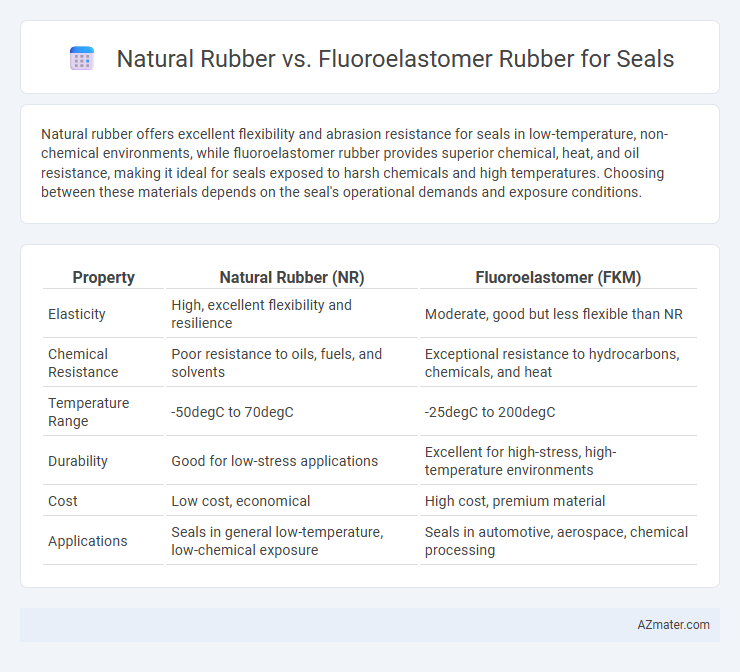Natural rubber offers excellent flexibility and abrasion resistance for seals in low-temperature, non-chemical environments, while fluoroelastomer rubber provides superior chemical, heat, and oil resistance, making it ideal for seals exposed to harsh chemicals and high temperatures. Choosing between these materials depends on the seal's operational demands and exposure conditions.
Table of Comparison
| Property | Natural Rubber (NR) | Fluoroelastomer (FKM) |
|---|---|---|
| Elasticity | High, excellent flexibility and resilience | Moderate, good but less flexible than NR |
| Chemical Resistance | Poor resistance to oils, fuels, and solvents | Exceptional resistance to hydrocarbons, chemicals, and heat |
| Temperature Range | -50degC to 70degC | -25degC to 200degC |
| Durability | Good for low-stress applications | Excellent for high-stress, high-temperature environments |
| Cost | Low cost, economical | High cost, premium material |
| Applications | Seals in general low-temperature, low-chemical exposure | Seals in automotive, aerospace, chemical processing |
Introduction to Seal Materials
Natural rubber offers excellent elasticity and resilience, making it suitable for seals requiring flexibility and compression set resistance. Fluoroelastomer rubber provides superior chemical, heat, and oil resistance, ideal for seals exposed to aggressive environments and high temperatures. Choosing between natural rubber and fluoroelastomer depends on the application's specific requirements for durability, environmental exposure, and operational conditions.
Overview of Natural Rubber
Natural rubber, derived from the latex of the Hevea brasiliensis tree, offers excellent elasticity, tensile strength, and abrasion resistance, making it ideal for seal applications in industries like automotive and manufacturing. Its superior flexibility and low compression set enable effective sealing under dynamic conditions but limit its chemical and temperature resistance compared to fluoroelastomer rubber. Natural rubber performs best in environments with moderate temperatures and exposure to water or diluted chemicals, whereas fluoroelastomers excel in harsh chemical and high-temperature applications.
Overview of Fluoroelastomer Rubber
Fluoroelastomer rubber (FKM) offers exceptional chemical resistance, high temperature tolerance up to 200-250degC, and excellent durability against oils, fuels, and solvents, making it ideal for seals in harsh environments. Compared to natural rubber, which excels in elasticity and abrasion resistance but degrades quickly under chemicals and heat, fluoroelastomers provide superior performance in automotive, aerospace, and industrial applications. The unique molecular structure of fluoroelastomers results in increased resistance to aging, compression set, and swelling, significantly extending seal lifespan in demanding conditions.
Performance in Chemical Resistance
Natural rubber exhibits limited chemical resistance, particularly vulnerable to oils, fuels, and solvents, making it unsuitable for harsh chemical applications in seals. Fluoroelastomer rubber offers superior resistance to a wide range of chemicals, including hydrocarbons, acids, and alkalis, maintaining integrity in aggressive environments. This chemical resistance advantage makes fluoroelastomers the preferred choice for seals exposed to harsh chemicals or extreme temperatures.
Temperature Tolerance Comparison
Natural rubber offers temperature tolerance typically ranging from -50degC to 70degC, making it suitable for moderate thermal conditions but limited in high-heat applications. Fluoroelastomer rubber excels with a broad temperature resistance from -26degC to 205degC, providing exceptional stability and sealing performance in extreme heat environments. This superior thermal tolerance of fluoroelastomers makes them ideal for seals in automotive, aerospace, and chemical processing industries where high temperature resilience is critical.
Durability and Longevity
Natural rubber offers excellent elasticity and resilience but suffers from poor resistance to oils, chemicals, and extreme temperatures, limiting its durability and longevity in harsh environments. Fluoroelastomer rubber, known for superior chemical resistance, high-temperature stability up to 200degC, and exceptional weathering properties, provides enhanced durability and extended service life in demanding sealing applications. Fluoroelastomers maintain their mechanical integrity and sealing performance over prolonged exposure to hydrocarbons, fuels, and aggressive chemicals, making them ideal for industrial and automotive seals requiring long-term reliability.
Cost Considerations
Natural rubber offers a cost-effective solution for seals, with lower material and production expenses compared to fluoroelastomer. Fluoroelastomer rubber, although more expensive upfront, provides superior chemical resistance and temperature stability, often justifying its higher price for specialized applications. Budget-conscious projects prioritize natural rubber for everyday sealing needs, while high-performance requirements typically necessitate fluoroelastomer despite its premium cost.
Environmental and Safety Aspects
Natural rubber seals offer superior biodegradability and lower environmental impact due to their renewable origin and natural decomposition process. Fluoroelastomer rubber seals provide exceptional chemical resistance and high-temperature stability but involve fluorinated compounds that pose challenges in recycling and potential environmental persistence. Choosing between the two requires balancing natural rubber's eco-friendly attributes with the advanced safety and durability characteristics of fluoroelastomers in demanding applications.
Ideal Applications for Each Material
Natural rubber offers excellent flexibility, abrasion resistance, and resilience, making it ideal for dynamic seals in automotive, industrial, and consumer products where low-temperature performance and resistance to tearing are critical. Fluoroelastomer rubber excels under high temperatures, chemical exposure, and aggressive fluid environments, making it the preferred choice for seals in aerospace, chemical processing, and fuel handling systems requiring exceptional heat resistance and chemical inertness. Selecting between natural rubber and fluoroelastomer depends on operational conditions such as temperature range, chemical exposure, and mechanical stress, ensuring optimal seal performance and longevity in specific applications.
Conclusion: Choosing the Right Seal Material
Selecting between natural rubber and fluoroelastomer for seals depends on application requirements such as temperature resistance, chemical exposure, and durability. Fluoroelastomer excels in high-temperature environments and chemical resistance, making it ideal for aggressive conditions, while natural rubber offers superior flexibility and cost-effectiveness for less demanding uses. Prioritizing operational conditions and budget constraints ensures the optimal seal material choice for performance and longevity.

Infographic: Natural rubber vs Fluoroelastomer rubber for Seal
 azmater.com
azmater.com